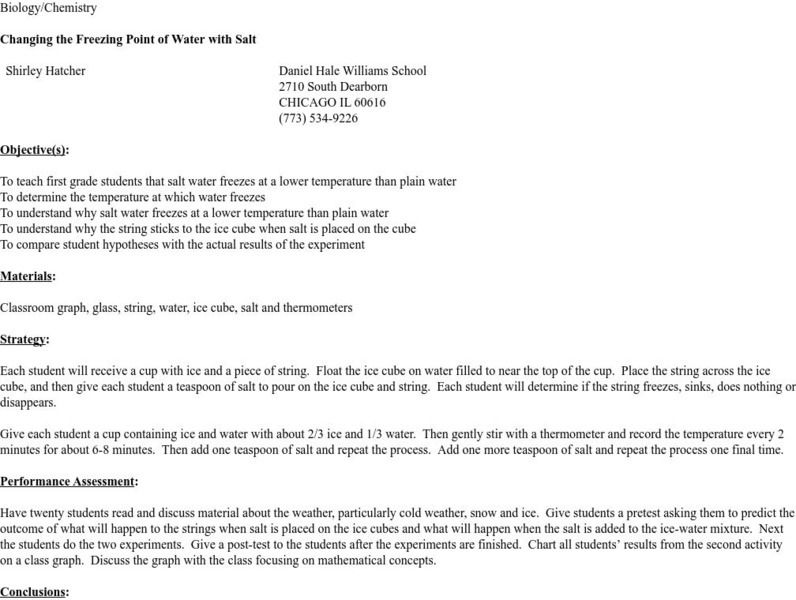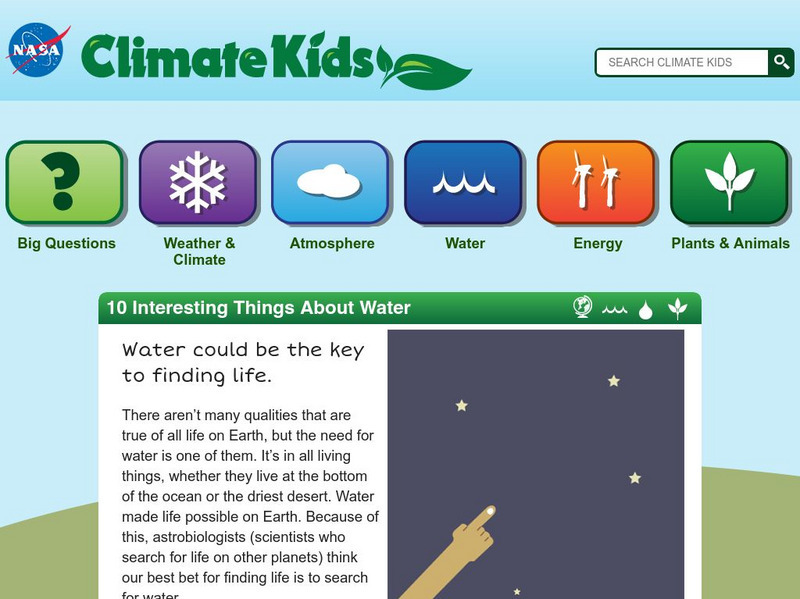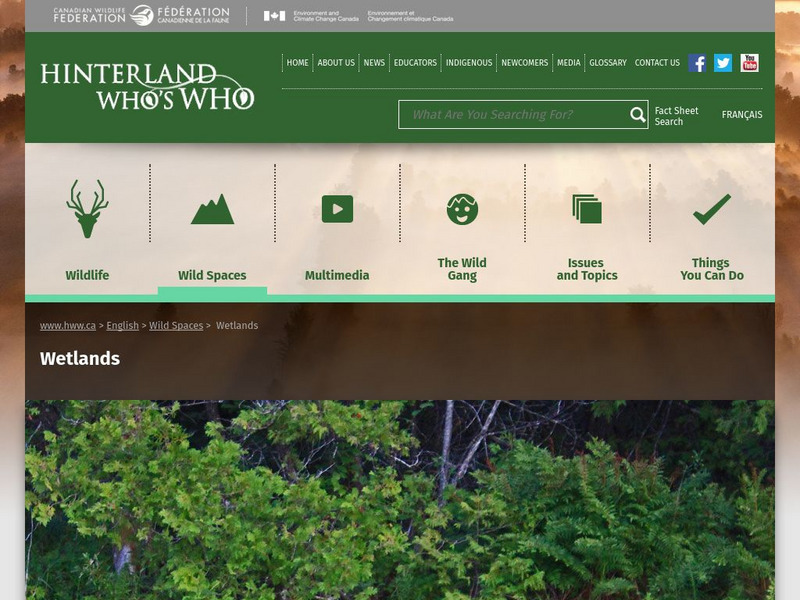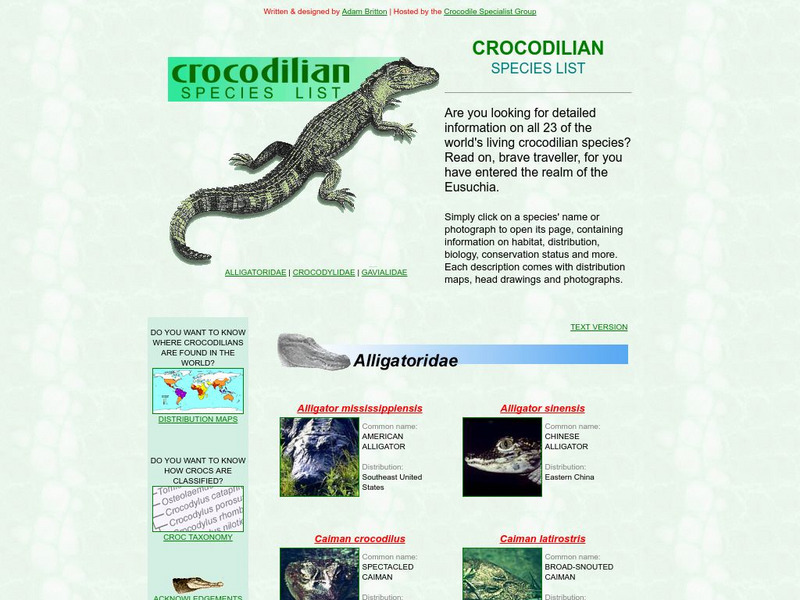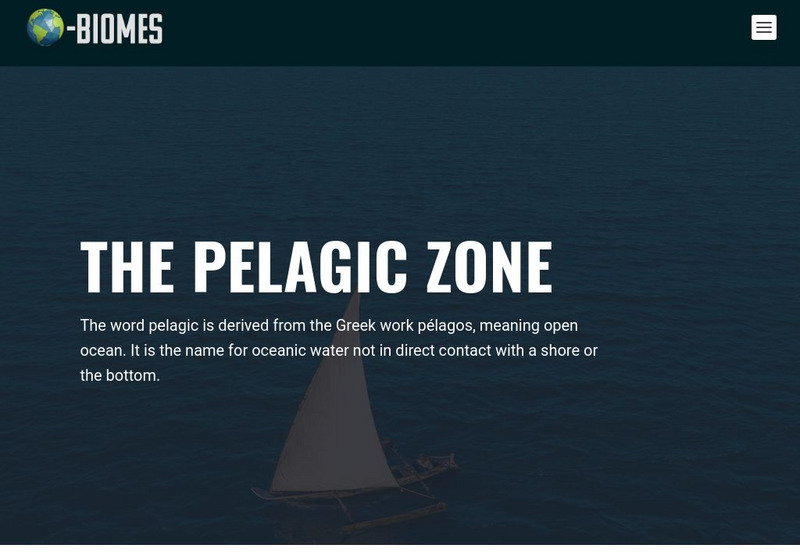PBS
Pbs Learning Media: The Water Planet
75% of our earth is covered by water. Water can be found in oceans, lakes, rivers, groundwater, and sea ice. View these captivating photos of our earth showing the different water sources and images of our earth taken by NASA. Background...
Science and Mathematics Initiative for Learning Enhancement (SMILE)
Smile: Changing the Freezing Point of Water With Salt
This lesson plan teaches first grade students basic chemistry and physics principles--that saltwater freezes at a lower temperature that plain water.
NASA
Climate Kids: 10 Interesting Things About Water
Discover 10 very interesting things about water, including sources of life, ocean ecosystems, freshwater and ice, salt and salt water, sources of water, the body's water makeup, plant's consumption of water and the 3 states of water.
American Chemical Society
Inquiry in Action: Changing the Density of a Liquid: Adding Salt
In this activity, students will see that a carrot slice sinks in fresh water and floats in saltwater. Considering the placement of the carrot slice in water and salt water, students will infer that the density of salt water must be...
TeachEngineering
Teach Engineering: Water Desalination Plant
Students use a thermal process approach to design, build and test a small-scale desalination plant that is capable of significantly removing the salt content from a saltwater solution. Students use a saltwater circuit to test the...
Idaho State University
Idaho State University: Water Pollution
Explore water pollution in surface water and groundwater and investigate the treatments for both. Also, check out what happens when salt water infiltrates the fresh water sources.
Canadian Wildlife Federation
Hinterland Who's Who: Wetlands
Learn about Canada?s wetlands, what they are and where they are located. Wetlands are divided into two classes: freshwater and saltwater. They are further separated into four main types: ponds, marshes, swamps, and peatbogs. Discover the...
Canadian Wildlife Federation
Hinterland Who's Who: Estuaries
Learn about estuaries, where the fresh water rivers meet the salt water of the oceans. The unique features of estuaries are explained, followed by a look into estuarine food webs. Next find out about the different plants and animals that...
Climate Literacy
Clean: Effects of Increased Co2 in the Air on Seawater and Distilled Water
Students perform an experiment comparing the impacts of CO2 on salt water and on fresh water. In a short demonstration, students examine how distilled water and seawater are affected differently by increasing carbon dioxide in the air.
TeachEngineering
Teach Engineering: Solar Power
In this activity, students learn how engineers use solar energy to heat buildings by investigating the thermal storage properties of some common materials: sand, salt, water and shredded paper. Students then evaluate the usefulness of...
TeachEngineering
Teach Engineering: Engineering for the Earth
Young students are introduced to the complex systems of the Earth through numerous lessons on its natural resources, processes, weather, climate and landforms. Key earth science topics include rocks, soils and minerals, water and natural...
TeachEngineering
Teach Engineering: Environment
Through 10 lessons and more than 20 hands-on activities, students are introduced to the concept of an environment and the many interactions within it. As they learn about natural and human-made environments, as well as renewable and...
TeachEngineering
Teach Engineering: The Keepers of the Gate Challenge
Learners are presented with a real-life problem as a challenge to investigate, research and solve. Specifically, they are asked to investigate why salt water helps a sore throat, and how engineers apply this understanding to solve other...
TeachEngineering
Teach Engineering: Cell Membrane Experimental Design
The final activity of this unit, which integrates the Keepers of the Gate unit through the Go Public challenge, involves students taking part in experimental design. They design a lab that answers the challenge question: "You are...
US Geological Survey
Usgs: Water Q & A
You will find this list of questions interesting and amusing. "Things like, "Is salt water used for anything in the U.S.?," and How can we have a 100-year flood two years in a row?", are found on this this. Click Home to access the site...
American Chemical Society
Middle School Chemistry: Lesson Plans: Why Does Water Dissolve Salt?
Young scholars use their own model of a salt crystal and water molecule to show how water dissolves salt. Then, they relate their observations to the structure of salt, water, and alcohol on the molecular level.
NOAA
Noaa: Estuaries 101 Curriculum: Nutrients in an Estuary
An overload of nutrients, called eutrophication (Greek for "good-nutrition"), can be harmful to estuaries. This phenomenon is also referred to as "over-enrichment," or "nutrient pollution". Students will investigate the range of...
Other
Crocodilian Species List
This website offers in-depth information and photos on all living crocodilian species.
State of Florida
Florida Department of State: State Symbols
Learn about all of Florida's state symbols on this colorful page. Click on the symbol for a larger picture and more information.
Other
The Nature Conservancy (Australia): 10 Weird and Wonderful Wildlife of Australia
Learn about some of the unique animals in Australia. A description of each animal and a high-resolution photograph are provided.
Georgia Department of Education
Ga Virtual Learning: Marine Invertebrates
Students learn about invertebrates found in the ocean, their individual methods of adaptations, identifying characteristics, and contributions to the marine ecosystem.
The Wild Classroom
The Wild Classroom: Biomes of the World: Intertidal Zone
Learn about the intertidal ecosystem. Find out about plants, animals, adaptations, and conservation efforts.
The Wild Classroom
The Wild Classroom: Biomes of the World: Coastal Ocean Biome
Learn about the coastal ecosystem. Find out about plants, animals, adaptations, and conservation efforts.
The Wild Classroom
The Wild Classroom: Biomes of the World: Oceanic Pelagic Biome
Learn about the oceanic pelagic ecosystem. Find out about plants, animals, adaptations, and conservation efforts.
Other popular searches
- Salt Water Chemistry
- Fresh Water Salt Water
- Freshwater and Saltwater
- Salt Water Aquariums
- Salt Water Freezing Point
- Saltwater Marsh
- Fresh and Salt Water
- Salt Water Biomes
- Detergents Saltwater
- Salt Water Experiments
- Salt Water Density
- Saltwater Aquariums

